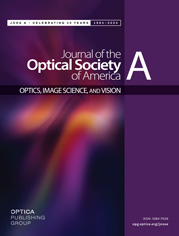Feature Issue of Applied Optics and JOSA A
Propagation Through and Characterization of Atmospheric and Oceanic Phenomena (pcAOP)
Submission Opens: 15 October 2023
Submission Deadline: 5 February 2024
Applied Optics and Journal of the Optical Society of America A (JOSA A) welcome submissions to a joint feature issue on "Propagation Through and Characterization of Atmospheric and Oceanic Phenomena (pcAOP)" in conjunction with the 2023 pcAOP meeting at the Optica Imaging Congress, which took place in a hybrid format on 14 - 17 August 2023 in Boston, Massachusetts, United States. Whereas meeting participants are particularly encouraged to submit their work, the feature issue is open to all contributions in related areas.
Submissions should emphasize research in the physics of light propagation, optical remote sensing and EO/IR effects in either the atmosphere or ocean. This includes distributed volume turbulence; boundary layer effects; gravity waves; vortex shedding; stably stratified turbulence, persistent eddies, and cloud/aerosol/vapor scattering and absorption; refractive effects, such as mirages and over-the-horizon viewing; as well as characterizations of these phenomena. In addition, the feature issue will consider works that highlight, use, or otherwise honor the contributions of David Fried to the community including the design of adaptive optics systems, anisoplanatism, and the importance and use of characteristic length scales such as the Fried parameter.
Topics of interest include, but are not limited to:
- Air/water distributed volume turbulence characterization, modeling and simulation including techniques using machine learning
- Methods and instrumentation used in experimental atmospheric or oceanic characterization including both in situ measurements and remote sensing
- Atmospheric and underwater optical and electro-magnetic field propagation
- Classic and quantum free-space optical communications through turbulence
- Conventional and unconventional imaging techniques for random media including both classical and machine learning and AI inspired techniques
- Interaction of structured light and orbital angular momentum of light with random media
- Meteorological phenomena occurring in the atmosphere and oceans such as non-Kolmogorov turbulence, interesting stratifications, inversion layers, etc.
- Models and measurements of aerosols and their impact including absorption, extinction, transmission and thermal blooming
- Neural networks for atmospheric/oceanic characterization and turbulence mitigation
- Understanding the impact of turbulent media with embedded scatterers on light propagation via theory, simulation and experimentation
- Empirical models of turbulence
- Test ranges, laboratories, and unique capabilities around the world
Authors may choose between Applied Optics and JOSA A when submitting to the joint feature issue, but should recognize the differences between them and select the appropriate journal. The guest editors may recommend transferring a manuscript to the other journal as needed. Papers will appear in their respective journals. Additionally, a combined table of contents of papers from both journals will appear once all papers are published.
Please prepare manuscripts according to the author instructions for submission to Applied Optics or JOSA A and submit through the Prism submission system, specifying from the drop-down menu that the manuscript is for the feature issue on Propagation Through and Characterization of Atmospheric and Oceanic Phenomena (pcAOP).
Feature Editors
Svetlana Avramov-Zamurovic, US Naval Academy, USA (Lead Editor)
Yalcin Ata, Ostim Technical University Turkey
Melissa Beason, AFIT, USA
Jeremy P. Bos, Michigan Technological University, USA
Andreas Muschinski, Northwest Research Associates, USA
Dario Perez, Pontificia Universidad Católica de Valparaíso (PUCV), Chile

